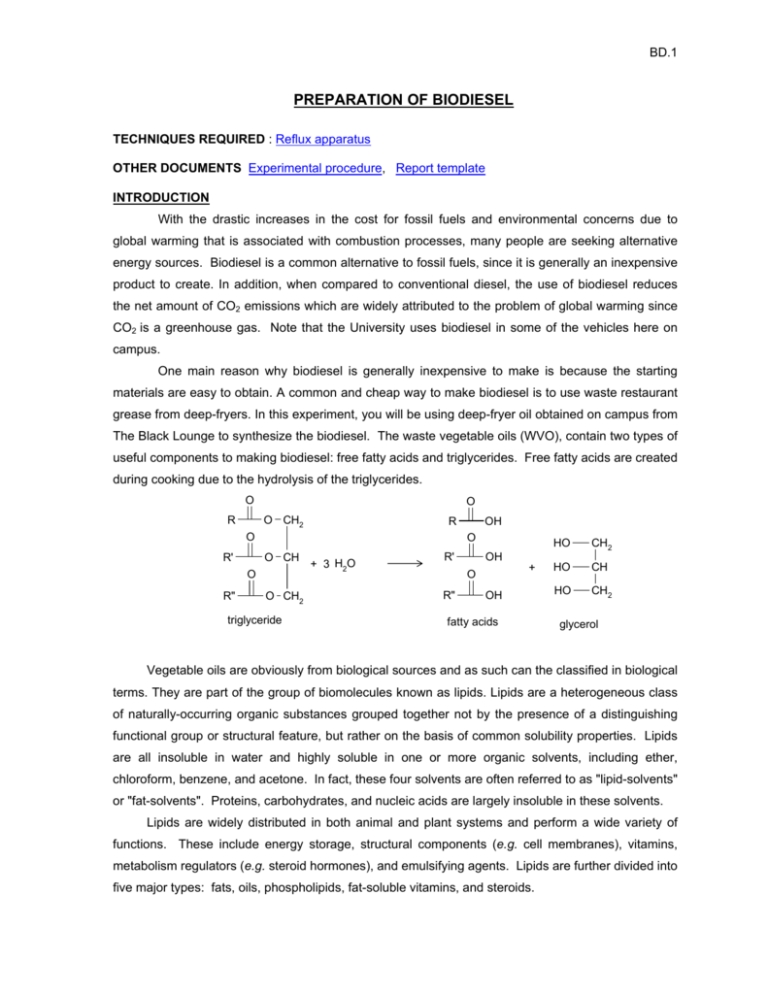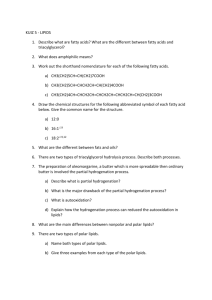Synthesis of Biodiesel
advertisement

BD.1 PREPARATION OF BIODIESEL TECHNIQUES REQUIRED : Reflux apparatus OTHER DOCUMENTS Experimental procedure, Report template INTRODUCTION With the drastic increases in the cost for fossil fuels and environmental concerns due to global warming that is associated with combustion processes, many people are seeking alternative energy sources. Biodiesel is a common alternative to fossil fuels, since it is generally an inexpensive product to create. In addition, when compared to conventional diesel, the use of biodiesel reduces the net amount of CO2 emissions which are widely attributed to the problem of global warming since CO2 is a greenhouse gas. Note that the University uses biodiesel in some of the vehicles here on campus. One main reason why biodiesel is generally inexpensive to make is because the starting materials are easy to obtain. A common and cheap way to make biodiesel is to use waste restaurant grease from deep-fryers. In this experiment, you will be using deep-fryer oil obtained on campus from The Black Lounge to synthesize the biodiesel. The waste vegetable oils (WVO), contain two types of useful components to making biodiesel: free fatty acids and triglycerides. Free fatty acids are created during cooking due to the hydrolysis of the triglycerides. O R O O CH2 R O R' O CH O R" OH O O CH2 triglyceride + 3 H2O OH R' O R" + OH fatty acids HO CH2 HO CH HO CH2 glycerol Vegetable oils are obviously from biological sources and as such can the classified in biological terms. They are part of the group of biomolecules known as lipids. Lipids are a heterogeneous class of naturally-occurring organic substances grouped together not by the presence of a distinguishing functional group or structural feature, but rather on the basis of common solubility properties. Lipids are all insoluble in water and highly soluble in one or more organic solvents, including ether, chloroform, benzene, and acetone. In fact, these four solvents are often referred to as "lipid-solvents" or "fat-solvents". Proteins, carbohydrates, and nucleic acids are largely insoluble in these solvents. Lipids are widely distributed in both animal and plant systems and perform a wide variety of functions. These include energy storage, structural components (e.g. cell membranes), vitamins, metabolism regulators (e.g. steroid hormones), and emulsifying agents. Lipids are further divided into five major types: fats, oils, phospholipids, fat-soluble vitamins, and steroids. BD.2 The most abundant lipids are triesters of glycerol with long-chain "fatty" acids. The triesters or triglycerides from animal sources are usually low-melting solids, and are called fats, while those from plants are viscous oils that solidify below 0°. The general structures are the same, and the difference in properties arises from the fact that the vegetable oils contain a larger proportion of unsaturated acid groups, with one, two or three double bonds in the chain. Triglycerides such as beef tallow and other depôt fats of animals contain mostly acid chains with one or no double bonds. Fatty acids invariably have chains with an even number of carbon atoms, most commonly 16 or 18. A few of the more important fatty acids are listed below. These and several others can occur in any combination in a given triglyceride. Typical Fatty Acids palmitic CH3(CH2)14CO2H stearic CH3(CH2)16CO2H palmitoleic CH3(CH2)5CH=CH(CH2)7CO2H oleic CH3(CH2)7CH=CH(CH2)7CO2H linoleic CH3(CH2)4(CH=CHCH2)2(CH2)6CO2H linolenic CH3CH2(CH=CH-CH2)3(CH2)6CO2H Butter fat is atypical, since the mixture of acids in the triester contains a significant number of 8-, 10- and 12-carbon chains. The composition of a few fats and oils is given in the table. These values vary over a fairly wide range, depending on the source of the oil, and there is no one "correct" figure. As a typical and representative vegetable oil, consider canola, i.e. corn oil Typical Fatty Acid Distribution in Fats and Oils (%) SATURATED FATTY ACIDS Beef fat Butter UNSATURATED FATTY ACIDS C12 C14 C16 C18 Other Palmitoleic Oleic Linoleic Linolenic Other 0 6.3 27.4 14.1 0 0 49.6 2.5 0 0 2.5 11.1 29.0 9.2 7.2 4.6 26.7 3.6 0 8.5 21 11 Canola oil 7 61 Corn oil 0 1.4 10.2 3.0 0 1.5 49.6 34.3 0 0 Cottonseed 0 1.4 23.4 1.1 1.3 2.0 22.9 47.8 0 0 Olive oil 0 trace 6.9 0.1 0 0 84.4 4.6 0 0 Palm oil 0 1.4 40.1 5.5 0 0 42.7 10.3 0 0 0 18.6 70.1 3.4 0 Soybean oil 0.2 0.1 9.8 2.4 0.9 0.4 28.9 50.7 6.5 0.1 Sunflower oil 0 0 5.6 2.2 0.9 0 25.1 66.2 0 0 oil Safflower oil 6.8 BD.3 The primary objective in making biodiesel is to convert the triglyceride into methyl esters. In this experiment, you will be performing a base-catalysed transesterification which converts the triglyceride content in the oil (> 98% of the oil content) into the methyl esters. Due to the differences in polarity between the methyl ester and glycerol, these two compounds are easily separable. Prior to starting the transesterification, the waste vegetable oil needs to be free of solid cooking residues and dried. This preparation of biodiesel is very similar to one of the methods used commercially. O R O O CH2 O R' OCH3 O R" O CH2 triglyceride OCH3 HO CH2 HO CH HO CH2 O KOH O CH + 3 CH3OH R' R + O R" OCH3 biodiesel glycerol Soap is a common byproduct in this reaction, which reduces the overall product yield. It is commonly formed when excess base is still present during the water washings of the oil. To prevent this, a small amount of concentrated ethanoic acid is added to neutralise the oil. The other by-product in the reaction scheme shown above is glycerol which is in itself a commercially useful material and hence it is not just "waste".







